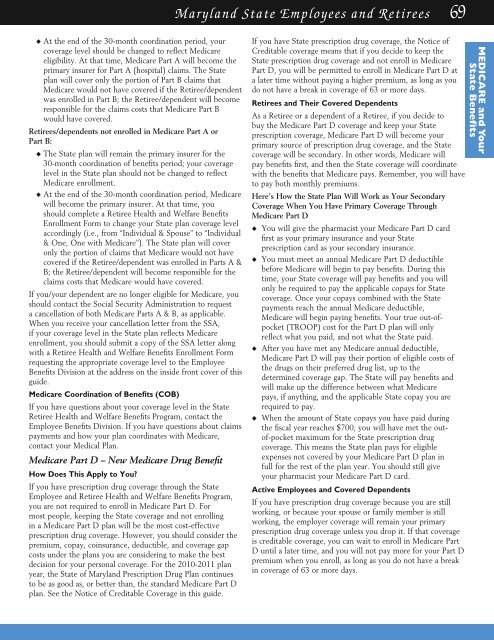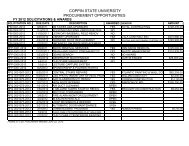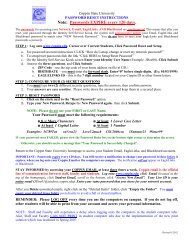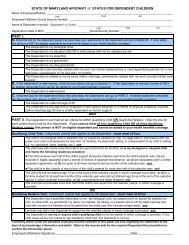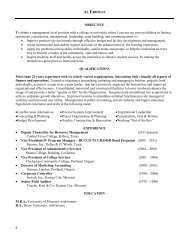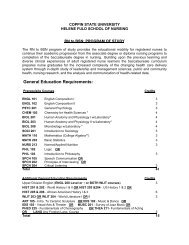FY2011 Health Benefits Booklet
FY2011 Health Benefits Booklet
FY2011 Health Benefits Booklet
Create successful ePaper yourself
Turn your PDF publications into a flip-book with our unique Google optimized e-Paper software.
Maryland State Employees and Retirees 69<br />
u At the end of the 30-month coordination period, your<br />
coverage level should be changed to reflect Medicare<br />
eligibility. At that time, Medicare Part A will become the<br />
primary insurer for Part A (hospital) claims. The State<br />
plan will cover only the portion of Part B claims that<br />
Medicare would not have covered if the Retiree/dependent<br />
was enrolled in Part B; the Retiree/dependent will become<br />
responsible for the claims costs that Medicare Part B<br />
would have covered.<br />
Retirees/dependents not enrolled in Medicare Part A or<br />
Part B:<br />
u The State plan will remain the primary insurer for the<br />
30-month coordination of benefits period; your coverage<br />
level in the State plan should not be changed to reflect<br />
Medicare enrollment.<br />
u At the end of the 30-month coordination period, Medicare<br />
will become the primary insurer. At that time, you<br />
should complete a Retiree <strong>Health</strong> and Welfare <strong>Benefits</strong><br />
Enrollment Form to change your State plan coverage level<br />
accordingly (i.e., from “Individual & Spouse” to “Individual<br />
& One, One with Medicare”). The State plan will cover<br />
only the portion of claims that Medicare would not have<br />
covered if the Retiree/dependent was enrolled in Parts A &<br />
B; the Retiree/dependent will become responsible for the<br />
claims costs that Medicare would have covered.<br />
If you/your dependent are no longer eligible for Medicare, you<br />
should contact the Social Security Administration to request<br />
a cancellation of both Medicare Parts A & B, as applicable.<br />
When you receive your cancellation letter from the SSA,<br />
if your coverage level in the State plan reflects Medicare<br />
enrollment, you should submit a copy of the SSA letter along<br />
with a Retiree <strong>Health</strong> and Welfare <strong>Benefits</strong> Enrollment Form<br />
requesting the appropriate coverage level to the Employee<br />
<strong>Benefits</strong> Division at the address on the inside front cover of this<br />
guide.<br />
Medicare Coordination of <strong>Benefits</strong> (COB)<br />
If you have questions about your coverage level in the State<br />
Retiree <strong>Health</strong> and Welfare <strong>Benefits</strong> Program, contact the<br />
Employee <strong>Benefits</strong> Division. If you have questions about claims<br />
payments and how your plan coordinates with Medicare,<br />
contact your Medical Plan.<br />
Medicare Part D – New Medicare Drug Benefit<br />
How Does This Apply to You?<br />
If you have prescription drug coverage through the State<br />
Employee and Retiree <strong>Health</strong> and Welfare <strong>Benefits</strong> Program,<br />
you are not required to enroll in Medicare Part D. For<br />
most people, keeping the State coverage and not enrolling<br />
in a Medicare Part D plan will be the most cost-effective<br />
prescription drug coverage. However, you should consider the<br />
premium, copay, coinsurance, deductible, and coverage gap<br />
costs under the plans you are considering to make the best<br />
decision for your personal coverage. For the 2010-2011 plan<br />
year, the State of Maryland Prescription Drug Plan continues<br />
to be as good as, or better than, the standard Medicare Part D<br />
plan. See the Notice of Creditable Coverage in this guide.<br />
If you have State prescription drug coverage, the Notice of<br />
Creditable coverage means that if you decide to keep the<br />
State prescription drug coverage and not enroll in Medicare<br />
Part D, you will be permitted to enroll in Medicare Part D at<br />
a later time without paying a higher premium, as long as you<br />
do not have a break in coverage of 63 or more days.<br />
Retirees and Their Covered Dependents<br />
As a Retiree or a dependent of a Retiree, if you decide to<br />
buy the Medicare Part D coverage and keep your State<br />
prescription coverage, Medicare Part D will become your<br />
primary source of prescription drug coverage, and the State<br />
coverage will be secondary. In other words, Medicare will<br />
pay benefits first, and then the State coverage will coordinate<br />
with the benefits that Medicare pays. Remember, you will have<br />
to pay both monthly premiums.<br />
Here’s How the State Plan Will Work as Your Secondary<br />
Coverage When You Have Primary Coverage Through<br />
Medicare Part D<br />
u You will give the pharmacist your Medicare Part D card<br />
first as your primary insurance and your State<br />
prescription card as your secondary insurance.<br />
u You must meet an annual Medicare Part D deductible<br />
before Medicare will begin to pay benefits. During this<br />
time, your State coverage will pay benefits and you will<br />
only be required to pay the applicable copays for State<br />
coverage. Once your copays combined with the State<br />
payments reach the annual Medicare deductible,<br />
Medicare will begin paying benefits. Your true out-ofpocket<br />
(TROOP) cost for the Part D plan will only<br />
reflect what you paid, and not what the State paid.<br />
u After you have met any Medicare annual deductible,<br />
Medicare Part D will pay their portion of eligible costs of<br />
the drugs on their preferred drug list, up to the<br />
determined coverage gap. The State will pay benefits and<br />
will make up the difference between what Medicare<br />
pays, if anything, and the applicable State copay you are<br />
required to pay.<br />
u When the amount of State copays you have paid during<br />
the fiscal year reaches $700, you will have met the outof-pocket<br />
maximum for the State prescription drug<br />
coverage. This means the State plan pays for eligible<br />
expenses not covered by your Medicare Part D plan in<br />
full for the rest of the plan year. You should still give<br />
your pharmacist your Medicare Part D card.<br />
Active Employees and Covered Dependents<br />
If you have prescription drug coverage because you are still<br />
working, or because your spouse or family member is still<br />
working, the employer coverage will remain your primary<br />
prescription drug coverage unless you drop it. If that coverage<br />
is creditable coverage, you can wait to enroll in Medicare Part<br />
D until a later time, and you will not pay more for your Part D<br />
premium when you enroll, as long as you do not have a break<br />
in coverage of 63 or more days.<br />
MEDICARE and Your<br />
State <strong>Benefits</strong>


